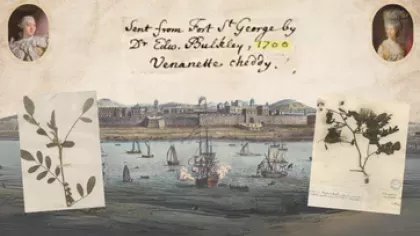17 July 2017
Enset: bananas on steroids!
Mair Bosley reveals the fascinating background behind enset, featuring in this summer's Science Festival.

I’m Mair Bosley and I’m working in Kew’s Office of the Science Directorate as we prepare for the upcoming Science Festivals at Wakehurst and Kew this summer. As the festival at Wakehurst is just around the corner, I caught up with two of the team who are bringing their exciting research out of the lab and into the gardens – and I must say, I’m very excited! Paul Wilkin and Tom Etherington will be talking about the importance of the crop plant ‘the banana on steroids’, otherwise known as enset (Ensete ventricosum). I’m especially looking forward to playing their bat pollination game.
What is enset?
Enset is a plant in the banana family that grows in the wild in eastern, central, and southern Africa. It has been cultivated for tens of thousands of years, exclusively in Ethiopia, becoming a staple crop for 20 million people. It is so ubiquitous within the country that it has over 200 common names – many of these reflecting its many uses and varieties. As well as providing food, parts of the plant are used in making rope, medicine, shelter, as feed for animals and even items of clothing like skirts. It’s also important ecologically – its roots hold together the soil and prevent erosion. It grows well with added animal manure, making it perfect for livestock farmers. Farmers often grow it alongside other crops too, providing an ideal microclimate for coffee, another Ethiopian native. You would be forgiven for mistaking enset for the plant that grows the bananas we eat due to its striking resemblance, earning it the title ‘false banana’. Enset has been called the 'banana on steroids' because of this resemblance, and its huge yield, allowing it to feed millions of people.
Enset is incredibly space-efficient, feeding more people per square meter of crop than most cereals, which currently provide half of Africa’s food. This makes it a key crop to focus on as the need to maximise the outputs of agricultural land in Africa grows ever more urgent. Enset can be made into three main foods – kocho, bulla and amicho.
The pulp of the roots and leaf sheaths is fermented underground for 4–6 months to make kocho, which is used in dough to make bread, and is slightly sour-tasting. Bulla is harvested from fully matured plants, and is used in soups and porridges; it can even be used to make pancakes. Amicho is the boiled root, and is similar to the familiar potato.
Enset is so wonderfully multi-purpose, it has earned the name 'the tree against hunger'. Indeed, it has been shown that enset forms the foundation of many households' food security. Another feature that makes enset special is its resilience – it can withstand drought, heavy rain and flooding much better than other crops. In the context of an ever-uncertain global climate, enset is a plant with huge potential.
However, somewhat surprisingly given its importance as a food crop, we know very little about the biology of enset. Kew’s scientists are embarking on projects to discover its secrets, from fruiting to fungi, as well as the mechanisms behind its impressive resilience.
What are our scientists bringing to the Science Festival?
Tom will be addressing the issue of distribution mapping – that is, where else can we grow this climate-smart crop in the future? You’ll be able to play enset top-trumps and help work out where enset can grow in Africa. Are there areas where it will become too hot or too rainy? Will this plant thrive where others have failed? Learn about what the scientists are doing to address food security issues around the world, and how we can predict the future climate.
Paul is bringing to life the ecology of this amazing crop – in the future it will be important that we can gather the seeds of key plants and help them survive. This is a particularly puzzling task for enset, as farmers take cuttings before the plants flower as a means of propagation. This means nobody is quite certain how enset is pollinated. Could bats be the answer? Come and have a go at helping our friendly toy bat catch pollen grains from our very own enset plant. You’ll also have a chance to find out about Paul’s work unravelling the genomes of the banana family.
Last but certainly not least, you’ll have the opportunity to try enset for yourself! Kocho, anyone?


